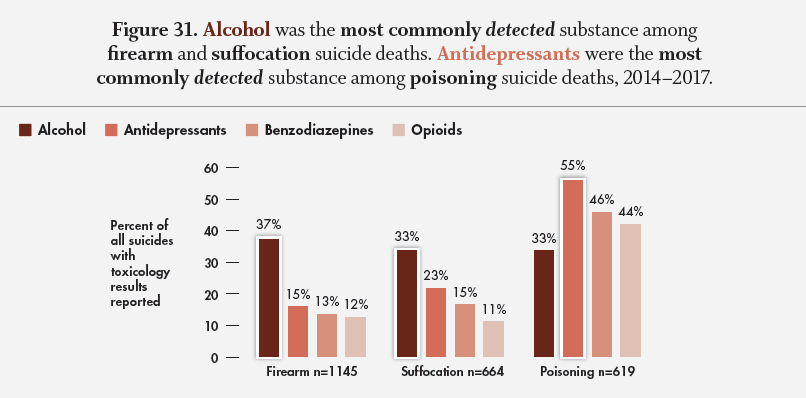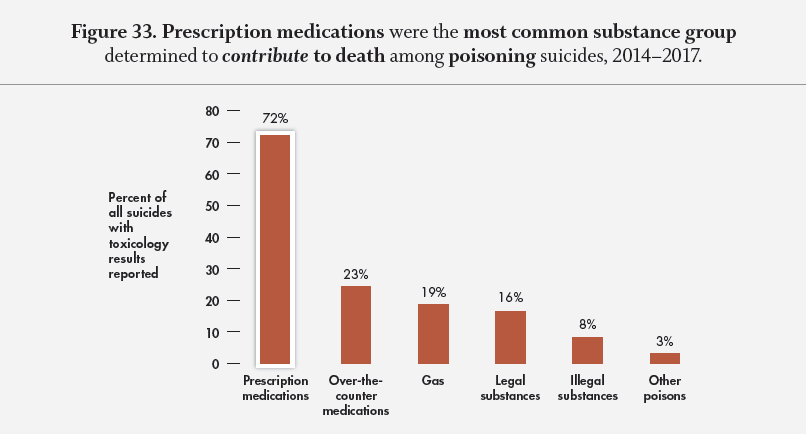Definitions:
- Detected substances: These are substances that have been detected in toxicology testing. This can be an indication of the decedent’s state of mind during the incident. Detected substances can be at levels that do not cause toxicity and may not have contributed to the cause of death. Detected substances are included for all suicide methods (such as poisoning, firearm, and suffocation).
- Substances that contributed to death: These are substances that the coroner or medical examiner determined reached toxic levels and impacted organ function resulting in death. Substances determined to contribute to death are included only for poisoning suicides.
Drugs, including prescription medications, are often involved in suicides even when they are not the cause of death. Use of alcohol and drugs by an individual under psychological duress may decrease one’s inhibitions, may promote feelings of depression and hopelessness, impair problem-solving abilities, and increase aggression.9 Alcohol and drug use may also be associated with suicide through shared risk factors, such as depression, impulsivity, or a tendency to pursue thrill-seeking or life-threatening behaviors.10
Data in this section was obtained from toxicology testing results. Approximately 63% of all suicides had toxicology results reported to WVDRS. Data was limited to 2014–2017 because several substances (anticonvulsants, antipsychotics, barbiturates, benzodiazepines, and muscle relaxants) were not added to WVDRS until August 2013.


Figure 30. Among the 63% of suicide deaths in which toxicology data were available, alcohol was the most commonly detected substance, followed by antidepressants, benzodiazepines, and opioids. Additionally, more than one substance was often detected among people who died by suicide. The average number of substances detected was 2.9, which indicates that many Wisconsin residents who died by suicide between 2014 and 2017 were using multiple substances at the time of death.

Figure 31. Based on the available data, alcohol was the most commonly detected substance among firearm and suffocation suicides. In contrast, antidepressants were the most commonly detected substance among poisoning suicide deaths.

Figure 32. Toxicology data can also provide information on the substances that are determined to directly contribute to poisoning suicide deaths. Among Wisconsin residents who died by poisoning suicide between 2014 and 2017, opioids were the most common type of substance determined to contribute to death, followed by antidepressants and benzodiazepines.

Figure 33. Prescription medications were determined to be the most common substance group that contributed to poisoning suicides among Wisconsin residents between 2014 and 2017.
Analytic notes: Prescription refers to medication prescribed by a doctor, such as oxycodone or AMBIEN®; over the counter (OTC) refers to medications available without prescription, such as Advil® or ZYRTEC®; gas refers to poisons that can be inhaled, such as carbon monoxide or propane; legal refers to substances available legally, such as alcohol or nicotine; illegal refers to substances not available legally or by prescription, such as heroin or cocaine; other poison refers to substances not intended for human consumption, such as household cleaners (does not include gas, which is a separate category).